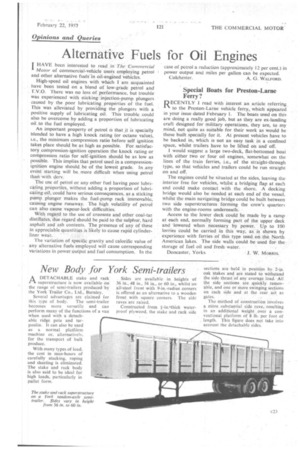Alternative Fuels for Oil Engines
Page 51

If you've noticed an error in this article please click here to report it so we can fix it.
I HAVE been interested to read in The Commercial Motor of commercial-vehicle users employing petrol and other alternative fuels in oil-engined vehicles.
High-speed oil engines with which I am acquainted have been tested on a. blend of low-grade petrol and T.V.O. There was no loss of performance, but trouble was experienced with sticking injection-pump plungers caused by the poor lubricating properties of the fuel. This was alleviated by providing the plungers with a positive supply of lubricating .oil. This trouble could also be overcome by adding a proportion of lubricating oil to the fuel employed.
An important property of petrol is that t is specially blended to have a high knock rating (or octane value), i.e., the minimum compression ratio before self ignition takes place should be as high as possible. For satisfactory compression-ignition operation the knock rating or compression ratio for self-ignition should be as low as possible. This implies that petrol used in a compressionignition engine should be of the lowest grade. In any event starting will be more difficult when using petrol than with derv.
The use of petrol or any other fuel having poor lubricating properties, without adding a proportion of lubricating oil, could have serious consequences, as a sticking pump plunger makes the fuel-pump rack 'immovable, causing engine runaway. The high volatility of petrol can also cause vapour-lock difficulties.
With regard to the use of creosote and other coal-tar distillates, due regard should be paid to the sulphur, hard asphalt and ash contents. The presence-of any of these in appreciable .quantities is likely to cause rapid cylinderliner wear.
The variation of specific gravity and calorific value of any alternative fuels employed will cause corresponding variations in power output and fuel consumption. In the case of petrol a reduction (approximately 12 per cent.) in power output and miles per gallon can be expected.
Colchester. A. G. WALFORD.
Special Boats for Preston-Larne Ferry?
RECENTLY I read with interest an article referring to the Preston-Lame vehicle ferry, which appeared in your issue dated February 1. The boats used on this are doing a really good job, but as they are ex-landing craft designed for military operations, they are, to my mind, not quite as suitable for their work as would be those built specially for it. At present vehicles have to be backed in, which is not an easy task in a confined space, whilst trailers have to be lifted on and off.
I would suggest a large two-deck, flat-bottomed boat with either two or four oil engines, somewhat on the lines of the train ferries, i.e., of the straight-through type, so that vehicles and trailers could be run straight on and off.
The engines could be situated at the sides, leaving the interior free for vehicles, whilst a bridging flap at each end could make contact with the shore. A docking bridge would also be needed at each end of the vessel, whilst the main navigating bridge could be built between two side superstructures• forming the crew's quarters with the engine-rooms underneath.
Access to the lower deck could be made by a ramp at each end, normally forming part of the upper deck and 'lowered when necessary by power. Up to 100 lorries could be carried in this way, as is shown by experience with ferries of this type used on the North American lakes. The side walls could be used for the storage of fuel oil and fresh water. • Doncaster, Yorks. J. W. MORRIS.
























































































